Keretapi Tanah Melayu Berhad (KTMB) or Malayan Railways Limited, colloquially referred to simply as KTM, is the main rail operator in Peninsular Malaysia. The railway system dates back to the British colonial era, when it was first built to transport tin. Previously known as the Federated Malay States Railways (FMSR) and the Malayan Railway Administration (MRA), Keretapi Tanah Melayu acquired its current name in 1962. The organisation was corporatised in 1992, but remains wholly owned by the Malaysian government.

Kuala Lumpur Sentral Station is a transit-oriented development that houses the main railway station of Kuala Lumpur, the capital of Malaysia. Opened on 16 April 2001, KL Sentral replaced the old Kuala Lumpur railway station as the city's main intercity railway station. KL Sentral is the largest railway station in Malaysia, and the second largest in Southeast Asia, behind Krung Thep Aphiwat Central Terminal in Bangkok, Thailand.

Butterworth is the city centre of Seberang Perai in the Malaysian state of Penang. It lies about 3 km (1.9 mi) east of George Town, the capital city of Penang, across the Penang Strait. As of 2020, Butterworth had a total population of 80,378 residents.

Seberang Perai is a city in the Malaysian state of Penang. It is situated on the Malay Peninsula opposite Penang Island, bordering Kedah to the north and east and Perak to the south. Its city centre is located in Butterworth, while its local authority, the Seberang Perai City Council, is centred near Bukit Mertajam. As of 2020, Seberang Perai had a population of 946,000, making it the third most populous city in Malaysia.

Rapid KL is a public transportation system owned by Prasarana Malaysia and operated by its subsidiaries Rapid Rail and Rapid Bus. With its coverage throughout Kuala Lumpur and Klang Valley areas, it was followed by a federal government restructuring of public transport systems in Kuala Lumpur after the bankruptcy of STAR and PUTRA Light Rapid Transit operators, the precursors to the Ampang/Sri Petaling Lines and Kelana Jaya Line respectively. In 2003, it had inherited bus services and assets formerly operated and owned by Intrakota and Cityliner after being bailed out. Four years later, the Malaysian government had bailed out KL Infrastructure Group, the owner and operation concession holder for the Kuala Lumpur monorail, and had placed it under ownership of Prasarana.
Prasarana Malaysia Berhad (Prasarana) (English: Malaysian Infrastructure Limited) is a 100% government-owned company which was set up by Ministry of Finance (Malaysia) as a corporate body established under the Minister of Finance (Incorporation) Act 1957 to own the assets of multi-modal public transport operator in Malaysia, under the government's move to restructure the city's public transport system. It is one of the largest public-transport companies in Malaysia other than Konsortium Transnasional Berhad. As a government-owned company since 1998, it operates stage bus and light metro services via several wholly owned subsidiaries.

Rail transport in Malaysia consists of heavy rail, light rapid transit (LRT), mass rapid transit (MRT), monorails, airport rail links and a funicular railway line. Heavy rail is mostly used for intercity services and freight transport as well as some urban public transport, while rapid transit rails are used for intracity urban public transport in the capital city of Kuala Lumpur and the surrounding Klang Valley region. There are two airport rail link systems linking Kuala Lumpur with the Kuala Lumpur International Airport and Sultan Abdul Aziz Shah Airport. The longest monorail line in the country is also used for public transport in Kuala Lumpur, while the only funicular railway line is available in Penang.
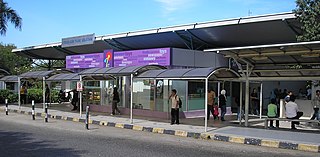
Bandar Tasik Selatan station (BTS) is a major Malaysian interchange station located next to and named after Bandar Tasik Selatan, in Kuala Lumpur. The station serves as both a stop and an interchange for the KTM Komuter's Seremban Line, KTM ETS, the LRT Sri Petaling Line, and the Express Rail Link's KLIA Transit trains. BTS is integrated with the Terminal Bersepadu Selatan bus hub (TBS). BTS and TBS are developed as an intermodal transportation hub.
Transport in Greater Kuala Lumpur includes a road network, a railway network, airports, and other modes of public transport. Greater Kuala Lumpur is conterminous with the Klang Valley, an urban conglomeration consisting of the city of Kuala Lumpur, as well as surrounding towns and cities in the state of Selangor. The Klang Valley has the country's largest airport, the Kuala Lumpur International Airport (KLIA), as well as the country's largest intermodal transport hub and railway station, Kuala Lumpur Sentral.

The State of Penang in Malaysia, home to the country's third largest city as well as part of Malaysia's second most populous conurbation, has a relatively well-developed transport infrastructure. The city-state is well-connected by land, air and sea; the Penang International Airport is one of Malaysia's busiest, while the Port of Penang is the main harbour and transshipment hub within northern Malaysia. The North–South Expressway, the main highway along western Peninsular Malaysia, runs through Penang, while the two geographically separate halves of the state are now linked by two bridges and a ferry service.
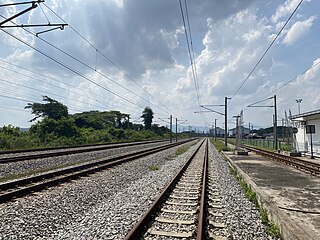
The West Coast railway line runs from Padang Besar railway station close to the Malaysia–Thailand border in Perlis to Woodlands Train Checkpoint in Singapore. It is called the West Coast railway line because it serves the West Coast states of Peninsular Malaysia.

The Butterworth railway station is a Malaysian railway station located at and named after the town of Butterworth, Penang.
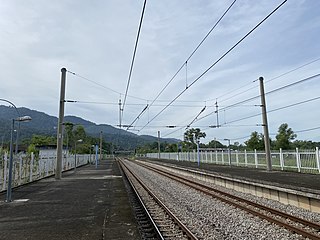
Railway electrification in Malaysia is a relatively recent development of rail transport in Malaysia. While the first railway in the country dates back to 1885, it was not until 3 August 1995 that the first electrified railway service, KTM Komuter, began operations.

The KTM ETS, commercially known as ETS, an acronym derived from Electric Train Service, is an inter-city higher-speed rail in Malaysia operated by Keretapi Tanah Melayu (KTM). The KTM ETS is the second electric train service to be operated by the Malaysian railway company after KTM Komuter, and the second inter-city rail service after KTM Intercity.
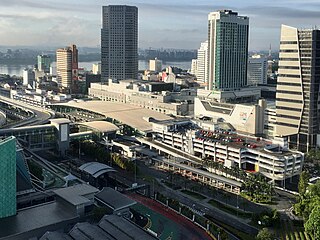
Johor Bahru Sentral is an integrated transport hub in Bukit Chagar, Johor Bahru, Johor, Malaysia.

The Greater Penang Conurbation, also known as the George Town Conurbation, is the built-up urban or metropolitan area within and around the Malaysian state of Penang. Encompassing all of Penang, and parts of the neighbouring states of Kedah and Perak, the conurbation was home to over 2.84 million people as of 2020, the second largest in the country after the Klang Valley.
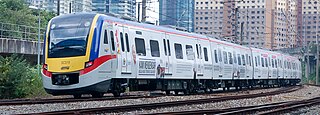
The KTM Batu Caves–Pulau Sebang Line, formerly known as the Seremban Line is one of the three KTM Komuter Central Sector lines provided by Keretapi Tanah Melayu. Its electric trains run between Batu Caves and Pulau Sebang/Tampin. Prior to 15 December 2015, the northern terminus of this line was Rawang.

Malaysian Resources Corporation Berhad is a Malaysian construction and property development company based in Kuala Lumpur. It is the master developer of the Kuala Lumpur Sentral transport hub and business district.

Kwasa Damansara is a new township located in the Sungai Buloh constituency of Selangor, Malaysia. Located 14 km northwest of Kuala Lumpur's central business district, it borders Kota Damansara to the south and Sungai Buloh to the north.
























